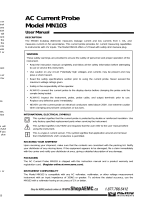
Power & Energy Logger Model PEL 105 - Quick Start Guide 13
Wi-Fi Direct Connection
Before you can connect through the PEL Control Panel, you must create a
Wi-Fi connection between the computer and instrument in Microsoft Windows. A
direct Wi-Fi connection requires the instrument’s SSID number and (if required)
password, which you can dene by connecting the instrument via USB cable,
opening the Control Panel, and displaying the Congure dialog box, as instructed
by the Control Panel Help. The Congure dialog box includes elds for setting
Wi-Fi connection options.
In addition, Wi-Fi must be enabled on the instrument to use this feature. Check
the Wi-Fi LED. If it is glowing steadily or blinking, Wi-Fi is enabled. If it is
OFF, press and hold it down until the LED lights up. Then release the
button to enable Wi-Fi. Your computer must also be Wi-Fi-enabled.
When you have completed these tasks, open the PEL Control Panel and proceed
as follows:
1. In the menu bar at the top of the screen, select Instrument.
2. In the drop-down menu that appears, click the option Add an Instrument.
3. Select Wi-Fi direct as the connection type, and complete the Add and
Instrument dialog. If you need assistance, press the Help button.
Point-to-Point Ethernet Cable
To connect via point-to-point Ethernet, your computer must be equipped with
an available Ethernet port. You must also have an Ethernet cable (purchased
separately).
1. Plug one end of the Ethernet cable into the instrument, and the other end into
the Ethernet port on the computer.
2. With the instrument connected, open the PEL Control Panel.
3. In the menu bar at the top of the screen, select Instrument.
4. In the drop-down menu that appears, click the option Add an Instrument. This
opens the Add an Instrument Wizard dialog box.
5. Select Point-to-point Ethernet cable (APIPA mode) as the connection type,
and complete the Add and Instrument dialog. If you need assistance, press
the Help button.
Ethernet Network via LAN or Wi-Fi
For this type of connection, the instrument must be connected to a network
accessible to the computer. The network connection can be either via LAN or
Wi-Fi router. Consult your network administrator if you need assistance with this.
When this connection is established, open the PEL Control Panel and do the
following:
1. In the menu bar at the top of the screen, select Instrument.
2. In the drop-down menu that appears, click the option Add an Instrument.
3. Select Ethernet (LAN or Wi-Fi) as the connection type, and complete the Add
and Instrument dialog. If you need assistance, press the Help button.




















